 Open Access Article
Open Access ArticleLithium-mediated electrochemical dinitrogen reduction reaction
Muhammad Saqlain
Iqbal†
b,
Yukun
Ruan†
a,
Ramsha
Iftikhar
 c,
Faiza Zahid
Khan
d,
Weixiang
Li
a,
Leiduan
Hao
*a,
Alex W.
Robertson
c,
Faiza Zahid
Khan
d,
Weixiang
Li
a,
Leiduan
Hao
*a,
Alex W.
Robertson
 e,
Gianluca
Percoco
f and
Zhenyu
Sun
e,
Gianluca
Percoco
f and
Zhenyu
Sun
 *a
*a
aState Key Laboratory of Organic–Inorganic Composites, College of Chemical Engineering, Beijing University of Chemical Technology, Beijing 100029, P. R. China. E-mail: haold@buct.edu.cn; sunzy@mail.buct.edu.cn
bDepartment of Electrical and Information Engineering, Polytechnic University of Bari, Via E. Orabona 4, 70125 Bari, Italy
cSchool of Chemistry, University of New South Wales, 2033 Sydney, Australia
dInstitute of Chemistry, Rheinische Friedrich-Wilhelms-Universität Bonn, 53113 Bonn, Germany
eDepartment of Physics, University of Warwick, Coventry CV4 7AL, UK
fDepartment of Mechanics, Mathematics and Management, Polytechnic University of Bari, Via E. Orabona 4, 70125 Bari, Italy
First published on 5th April 2023
Abstract
The Haber–Bosch process is the dominant approach for NH3 production today, but the process has to be maintained at energy-intensive high temperatures and pressures. Li-mediated electrocatalytic dinitrogen reduction reaction (eN2RR) could instead enable sustainable and green NH3 production at ambient conditions. Lithium mediators realize the synthesis of NH3via the formation of Li3N, and thus lower the energy required for the direct cleavage of N2. There has now been a surge of interest in devising approaches to optimize the NH3 yield rate and faradaic efficiency of the eN2RR process by employing different catalysts as well as electrolytes. This review discusses the recent advances in the field of the Li-mediated eN2RR along with the latest insights into the proposed catalytic mechanisms. Moreover, it also highlights the state-of-the-art reported electrocatalysts and electrolytes that have revolutionized the field of the Li-mediated eN2RR. In addition to the above, our review provides a critical overview of certain limitations and a future prospectus that will provide a way forward to explore this area.
Keywords: Nitrogen reduction reaction; Ammonia; Electrocatalysis; Lithium; Reaction mechanism.
1 Introduction
Ammonia (NH3) is a crucial chemical fertilizer for crop development that has supported the rapid increase in our global population. It has high hydrogen content, a large gravimetric energy density comparable to methanol, and is easy to liquefy for storage and transit, among other beneficial properties. The global production of NH3 is expected to increase to about 290 million tons by 2030. In 2022, the global ammonia market was valued at USD 78.26 billion and is expected to reach USD 129.63 billion by 2030, with a projected compound annual growth rate (CAGR) of 6.51% during the forecast period from 2022 to 2030 (Fig. 1).2Table 1 provides an overview of the global NH3 market from 2021 to 2030, including the market size in 2022 and the projected market size by 2030, with a forecasted CAGR of 6.51% from 2022 to 2030. The report studied different global regions, and found that the Asia-Pacific region is the largest market for ammonia products, followed by North America. The report also accounted for different segments of the ammonia market, including the product form and application.2 The large-scale centralized Haber–Bosch (HB) process is the current favored industrial technique for realizing this sizeable international demand and delivering the mass production of NH3. In the HB process N2 reacts with H2 (N2 + 3H2 → 2NH3) on an Fe-based catalyst, and is typically operated at high temperatures (400–500 °C) and high pressure (150–250 bar), resulting in high energy use and cost.1 Due to the combination of high and growing demand for NH3, and the high temperature requirements of the HB process, it is urgent to develop new catalysts and procedures for NH3 synthesis that can reduce the energy required and the carbon footprint.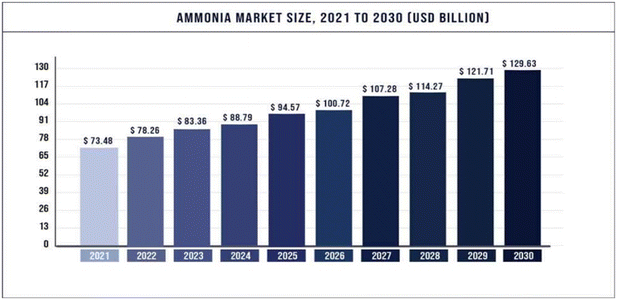 | ||
| Fig. 1 Projected global ammonia demand growth from 2021 to 2030.2 Copyright 2023, Precedence Research. | ||
| Report coverage | Detail |
|---|---|
| Market size in 2022 | USD 78.26 billion |
| Market size by 2030 | USD 129.63 billion |
| Growth rate from 2022 to 2030 | CAGR of 6.51% |
| Largest market | Asia-Pacific |
| Second largest market | North America |
| Base year | 2021 |
| Forecast period | 2022 to 2030 |
| Segments covered | • By product form |
| • By application | |
| Regions covered | • North America |
| • Europe | |
| •Asia-Pacific | |
| • Latin America | |
| •Middle East & Africa |
In order to find alternatives to the energy-intensive H–B process, scientists have searched for catalysts that might avoid the direct cleavage of the dinitrogen triple bond and that can produce NH3 when powered by electricity.3,4 The reduction of dinitrogen (N2) by electrocatalysis has been studied extensively over the past few years using a variety of electrocatalysts. However, it has been revealed that even the best reported catalysts could only use 1% of the electrons to produce NH3 in aqueous solutions because of the competitive hydrogen evolution reaction (HER). Recently, the lithium-mediated N2 reduction reaction (Li-eN2RR) has been found to be a promising route for electrochemical NH3 synthesis at ambient conditions. The Li-eN2RR was first attempted in an alcoholic solution of lithium halide in 1930 by Fichter and coworkers.5 Tsuneto et al. further improved the faradaic efficiency (FE) by employing an electrolyte with tetrahydrofuran (THF) mixed with ethanol (EtOH) and increasing the N2 pressure.6 Lee et al.7 reported that lithium used along with the electrolyte solution acted as a mediator, as the Li+ ions after reduction allow for the conversion of N2 gas into Li3N. Moreover, this Li-mediated system can be modified with superhydrophobic metal organic frameworks (MOFs) to suppress the competing HER and enhance the eN2RR. The greatest advantage of Li-eN2RR is that the active Li and inert proton source can promote N2 activation and hinder H2 evolution, respectively. However, a majority of Li-eN2RR studies have the limitation of using a sacrificial solvent as a proton donor, prohibiting the scale up synthesis in batch cells.
2 Li-mediated eN2RR
For NH3 synthesis, a wide range of different catalytic materials and systems have been investigated. It has been suggested that Li in particular holds the potential of producing NH3 at ambient pressure. The rate-determining step in the synthesis of NH3 is often the adsorption and activation of N2.8–14 Li has an extraordinarily low work function and high reactivity for this process. Li can therefore be used to break the strong N![[triple bond, length as m-dash]](https://www.rsc.org/images/entities/char_e002.gif) N triple bond and fix N2 as Li3N, which subsequently converts to NH3. Additionally, Li+ ions have been shown to disrupt the water molecule, which lowers the rate of water splitting.15 According to the study by McEnaney et al., Li may undergo electro-cycling to create NH3 in a molten electrolyte at atmospheric pressure with an extremely high NH3 FE of 88.5%.1 A larger applied energy (potential) is required for the electrodeposition of Li at the cathode, which stabilizes N2 in the form of Li3N. This study further demonstrated that Li0 can facilitate the electrochemical reduction of N2 to NH3. An NH3 FE of 57.7% was attained with an Fe electrode using 0.2 M LiClO4 in THF as the electrolyte and 0.18 M ethanol as the proton source while operating under high pressure (50 atm) of N2.6 Li+ ions were found to inhibit the competitive HER on the surface of Pt while promoting the HER on Au.16 As opposed to this study, Suo et al. instead attributed the suppression of the HER to the decomposition of the TFSI anion in the formed lithium bis(trifluoromethane sulfonyl) imide (LiTFSI) salt. Due to the electrodes' weak selectivity for N2 reduction, ambient eN2RR in an aqueous electrolyte remains a difficult task.17,18 Since the standard potential needed for the eN2RR is close to that of the HER, the N2 reduction reaction in aqueous electrolytes is usually accompanied by the HER.19 Therefore, approaches that either hamper the HER by changing to an electrocatalyst with weak H+ adsorption, or by changing the electrolyte (for instance, to non-aqueous systems) are required to be developed.20
N triple bond and fix N2 as Li3N, which subsequently converts to NH3. Additionally, Li+ ions have been shown to disrupt the water molecule, which lowers the rate of water splitting.15 According to the study by McEnaney et al., Li may undergo electro-cycling to create NH3 in a molten electrolyte at atmospheric pressure with an extremely high NH3 FE of 88.5%.1 A larger applied energy (potential) is required for the electrodeposition of Li at the cathode, which stabilizes N2 in the form of Li3N. This study further demonstrated that Li0 can facilitate the electrochemical reduction of N2 to NH3. An NH3 FE of 57.7% was attained with an Fe electrode using 0.2 M LiClO4 in THF as the electrolyte and 0.18 M ethanol as the proton source while operating under high pressure (50 atm) of N2.6 Li+ ions were found to inhibit the competitive HER on the surface of Pt while promoting the HER on Au.16 As opposed to this study, Suo et al. instead attributed the suppression of the HER to the decomposition of the TFSI anion in the formed lithium bis(trifluoromethane sulfonyl) imide (LiTFSI) salt. Due to the electrodes' weak selectivity for N2 reduction, ambient eN2RR in an aqueous electrolyte remains a difficult task.17,18 Since the standard potential needed for the eN2RR is close to that of the HER, the N2 reduction reaction in aqueous electrolytes is usually accompanied by the HER.19 Therefore, approaches that either hamper the HER by changing to an electrocatalyst with weak H+ adsorption, or by changing the electrolyte (for instance, to non-aqueous systems) are required to be developed.20
The Li-mediated eN2RR for NH3 synthesis driven by renewably generated electricity has garnered a lot of recent scientific interest.21–23 Due to competition with HER and the high stability of the N![[triple bond, length as m-dash]](https://www.rsc.org/images/entities/char_e002.gif) N triple bond, the key challenge is to significantly improve efficiency and the rate of NH3 generation. Ethanol is frequently applied as the local proton source, which however may deteriorate in the reaction environment. In a THF solution containing 1% ethanol, Lazouski et al. attained an NH3 production rate of 7.9 × 10−9 mol cm−2 s−1and a maximum NH3 FE of 18.5% via the Li-mediated eN2RR.11 A more encouraging result was achieved in a phosphonium salt in place of ethanol, with an NH3 production rate approaching approximately 6.0 × 10−8 mol cm−2 s−1 and an NH3 FE of roughly 69% for 20 h under 0.05 MPa H2 and 1.95 MPa N2.24
N triple bond, the key challenge is to significantly improve efficiency and the rate of NH3 generation. Ethanol is frequently applied as the local proton source, which however may deteriorate in the reaction environment. In a THF solution containing 1% ethanol, Lazouski et al. attained an NH3 production rate of 7.9 × 10−9 mol cm−2 s−1and a maximum NH3 FE of 18.5% via the Li-mediated eN2RR.11 A more encouraging result was achieved in a phosphonium salt in place of ethanol, with an NH3 production rate approaching approximately 6.0 × 10−8 mol cm−2 s−1 and an NH3 FE of roughly 69% for 20 h under 0.05 MPa H2 and 1.95 MPa N2.24
In order to alleviate the unwanted HER and achieve an initial current efficiency of 88.5%, electrochemical lithium cycling was proposed as an effective method for manufacturing NH3, which requires independent steps of LiOH electrolysis, direct nitridation of Li, and release of NH3 from Li3N. However, this multi-step process is difficult to operate, and the step that involves LiOH electrolysis for Li regeneration is particularly challenging. Jain et al. synthesized NH3 through hydrolysis of Li3N at 80 °C in a closed cycle and Li-metal was reproduced at the end of the reaction.25 In addition to using Li–Sn alloys for breaking the N![[triple bond, length as m-dash]](https://www.rsc.org/images/entities/char_e002.gif) N triple bond to produce Li3N, which was subsequently used for NH3 synthesis below 500 °C under 0.5 MPa, Yamaguchi et al. also reported the use of pure Li to fix N2. The same research group has recently established a three-step pseudo-catalytic method for the production of NH3 below 400 °C under 0.1 MPa by reacting solid Li–Sn alloy with N2 and H2 consecutively, followed by regeneration of the initial alloy in a chemical loop. The maximum molar proportion of NH3 is equivalent to one-tenth of the composition at thermodynamic equilibrium. The Li–Sn catalyst system's stability, however, was not the subject of a thorough study. Since the solid Li–Sn alloy, as well as the produced Li3N and LiH, are sensitive to O2 and H2O, its deactivation is a significant problem.26 Additionally, the scaling relationship between the activation barrier for N2 dissociation and the N2-binding energy limits Li, much like it does for transition metals (TMs). In Li3N, nitrogen is strongly bound to lithium. Li3N can react with H2 to produce a mixture of LiNH2, Li2NH, and LiH at relatively low temperatures, but it is difficult to further hydrogenate LiNH2 and Li2NH to produce LiH and NH3 for both thermodynamic and kinetic reasons.
N triple bond to produce Li3N, which was subsequently used for NH3 synthesis below 500 °C under 0.5 MPa, Yamaguchi et al. also reported the use of pure Li to fix N2. The same research group has recently established a three-step pseudo-catalytic method for the production of NH3 below 400 °C under 0.1 MPa by reacting solid Li–Sn alloy with N2 and H2 consecutively, followed by regeneration of the initial alloy in a chemical loop. The maximum molar proportion of NH3 is equivalent to one-tenth of the composition at thermodynamic equilibrium. The Li–Sn catalyst system's stability, however, was not the subject of a thorough study. Since the solid Li–Sn alloy, as well as the produced Li3N and LiH, are sensitive to O2 and H2O, its deactivation is a significant problem.26 Additionally, the scaling relationship between the activation barrier for N2 dissociation and the N2-binding energy limits Li, much like it does for transition metals (TMs). In Li3N, nitrogen is strongly bound to lithium. Li3N can react with H2 to produce a mixture of LiNH2, Li2NH, and LiH at relatively low temperatures, but it is difficult to further hydrogenate LiNH2 and Li2NH to produce LiH and NH3 for both thermodynamic and kinetic reasons.
The question of how to overcome Li's scaling relation is an enormous challenge but has been rarely studied. One method discussed by McEnaney calls for separate N2 fixation stages in the absence of a proton source and the subsequent exothermic release of NH3 by exposing the solid Li3N to H2O rather than H2.1 While TMs offer insights into catalyst design, further work has been reported on circumventing the scaling relation imposed on TMs. For instance, introducing alkali metals or oxides as promoters resulted in an increased NH3 synthesis rate and mitigated the well-known pure-TM scaling relation by creating local electrical fields.27,28 Wang et al. also found that employing LiH to mediate N2 transfer and NH3 production broke the scaling relation on TMs. Instead of using Li's high activity to fix N2, LiH's negatively charged hydrogen ions can serve as potent reducing agents when reacting with N2 atoms that have been activated by the right solid-state transition metal to create LiNH2. Then, H2 and LiNH2 interact to form NH3 and regenerate LiH. The LiH and TM work together to overcome the scaling relation on TMs and enable an energy-efficient NH3 production.29 Additionally, NH3 synthesis was demonstrated to be mediated by alkali or alkaline earth metal hydride/imide pairings (e.g., LiH/Li2NH, BaH2/BaNH) with an ability to disrupt the scaling relation comparable to Fe, Co, and Ni in the N2 fixation stage.30
The most commonly used aqueous electrolytes in NH3 synthesis include alkaline electrolytes (KOH and KHCO3),31,32 acidic electrolytes (HCl and H2SO4), and LiClO4- and Li2SO4-based neutral electrolytes.3,33 These Li-mediated aqueous electrolytes have been identified as promising potential electrolytes due to the improved interaction between Li+ and N2.34,35 Because large cations include core electrons, the stabilizing impact of the electrostatic and induction effects on the total energy is constrained, leading to the conclusion that Li+ is more effective than Na+ for N2 adsorption.36 An order of Ca2+ > Na+ > Li+ was proposed, in which the adsorption energies for N2 decrease.35 Chen et al. recently employed the Li+ incorporation approach, which not only resulted in slow kinetics and a higher energy barrier for the generation of H2, but also provided suitable eN2RR sites. LiClO4 has been demonstrated to deliver better NH3 FE and yield rate compared to NaClO4 and KClO4 electrolytes because of the improved interactions between Li+ and N2.32
The performance of eN2RR is dependent on the electrolysis current and the freshness of lithium deposits. A higher current results in fresher lithium deposits, which exposes more active lithium to nitrogen and enhances eN2RR. In contrast, a low current leads to passivation of lithium, deteriorating its reactivity towards eN2RR. Strategies such as retarding passivation or creating a protective layer may be employed to improve N2RR efficiency. One approach is to use electrolyte additives to engineer the solid-electrolyte interphase to create a protective layer that is impervious to electrolyte but penetrable by nitrogen and proton source.37
Although there are still obstacles to the practical viability of lithium-mediated ammonia synthesis, such as the need for a replacement for the sacrificial proton source, a promising alternative to N2 pressure for independently increasing the mass transport of N2 relative to protons could be the use of gas diffusion electrodes. According to the model by Andersen,38 a higher rate at a similar FE could be achieved if the transfer rate of N2 to the surface were to be increased proportionally. This model highlights the unique features of the lithium-mediated process. Lithium has a strong binding affinity for nitrogen and a low barrier for N2 dissociation,1 similar to early transition metals and nitrides.19,39 However, only lithium has been shown to develop a protective solid electrolyte interphase (SEI) layer. This passivating layer plays a crucial role in determining the system's function and catalytic performance.
2.1 Reaction mechanisms of Li-mediated N2 reduction
 | (1) |
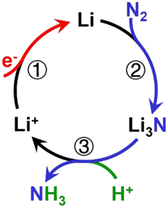 | ||
| Fig. 2 Mechanism of catalytic recycling of lithium intermediates. Reproduced with permission.23 Copyright 2021, Wiley-VCH. | ||
Likewise, Cai et al. provided a detailed mechanisms of eN2RR where the majority (>99%) of the electrochemical reaction is Li deposition, while the subsequent chemical reactions of N2 activation and protonation are primarily chemical in nature (Fig. 3). They further demonstrated that another significant competing reaction is the interaction between Li deposits and THF. Substantial reactivity for N2 activation is only present in recently deposited Li. After being deactivated by THF, the newly deposited Li gradually loses its ability to reduce N2. Therefore, protecting “fresh” metallic Li is essential to enhancing N2 reduction performance. This “fresh Li” technique also explains how performance is influenced by current density. A high level of NH3 FE and NH3 yield rate were obtained through this mechanism.40
 | ||
| Fig. 3 (a) A ‘Heterogeneous mechanism’, in which there is a stable amount of lithium on the electrode at all times; (b) free energy diagram of NH3 formation on the surfaces of Li, Li3N, and LiH. The free energy diagram is represented through dash lines when the limiting potential is switched on. All of these surfaces are active for NH3 synthesis.41 | ||
Schwalbe and coworkers41 combined experiment with density functional theory (DFT) modeling and revealed that plated Li could react with N2 and ethanol to form Li3N and LiH, and that the active centers on the surfaces of Li, Li3N, and LiH are the long-bridge site, the nitrogen vacancy, and the hydrogen vacancy, respectively.41 Based on DFT calculations, they inferred that Li-eN2RR could follow a heterogeneous mechanism (Fig. 3a). N2 is first adsorbed onto the solid surface composed of Li, Li3N, and LiH. It is then activated on the surface and the activated N2 is protonated stepwise to form NH3. They also showed that Li3N is kinetically stable but not thermodynamically stable. There could therefore be a bottleneck in the diffusion of vacancies from the bulk to the surface, which limits the decomposition of Li3N to Li and NH3. The authors proposed plausible pathways on the surfaces of Li, Li3N, and LiH, depicted in Fig. 3b. The necessary limiting potentials on the corresponding surfaces are −0.76, −1.33, and −1.53 V against the reversible hydrogen electrode (RHE), respectively. Before the formation of NH3, all routes pass through absorbed NHx. It is essential to remember that the determination of the limiting potential makes use of the computational hydrogen electrode (CHE) assumptions.42 The CHE assumes the pH of the aqueous electrolyte is known. They employed onset potential for ethanol reduction from the trials as a baseline to account for the nonaqueous electrolyte present in this experiment. The results showed that under the conditions of these trials, all three surfaces are capable of assisting in the production of NH3.41
 | (2a) |
 | (2b) |
 | (2c) |
 | (2d) |
 | (2e) |
 | (2f) |
 | (2g) |
 | (2h) |
 | (2i) |
 | (2j) |
∴ Li˙ = active surface site of Li
∴ Li˙X* = surface bound X species
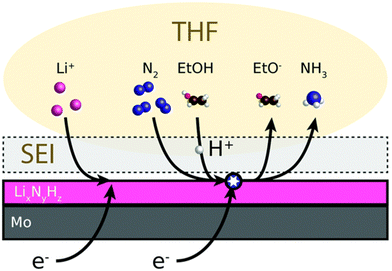 | ||
| Fig. 4 Schematic of the mechanism for Li-eN2RR to NH3. A non-aqueous electrolyte (THF) contains lithium salt which is electrodeposited onto a metal electrode (Mo) as metallic Li.38 | ||
Here eqn (2a) and (2b) describe the slow steps of Li-deposition, while eqn (2c)–(2e) and (2f)–(2j) show the catalytic formation of H2 and NH3, respectively.
There have been several computational studies on the reaction mechanism of Li-mediated N2 reduction and understanding the factors that influence the efficiency and selectivity of this process. These studies have used a variety of computational techniques, including DFT calculations, to examine the reaction pathways and intermediate species involved in the reduction of N2 to NH3 using lithium as a mediator. Some of the key findings from these computational studies include the importance of the choice of electrocatalyst, as different electrocatalysts have been found to have a significant impact on the reaction mechanism and efficiency of the Li-mediated N2 reduction process. The formation and stability of intermediate species, such as lithium nitride and lithium amide, have been found to play a key role in the reaction mechanism of Li-mediated N2 reduction. The influence of electrolytes also has significant impact on the reaction mechanism.40,43–46
Maniscalco et al. employed a Car–Parrinello molecular dynamics (CPMD) method to simulate the first step of Li-mediated NH3 synthesis. CPMD, a type of ab initio molecular dynamics method (AIMD), is a classical technique, which is well known from classical molecular dynamics (or force-field) calculations, to address the challenge of how to characterize nuclear motion in a simple manner. The DFT method was employed for the studies of electronic structure and the motions in the system, which were further characterized through CPMD.47
At every step, the electronic cloud tracks the nuclei's movement. The dynamics of molecular systems on the size of a few ps and a few NH3 can be described using a time interval of around 0.1 fs. Since chemical reactions are infrequent events, it is challenging to meaningfully simulate them. Before monitoring reactions, it is especially preferable to build an equilibrium system with a precise temperature. Such equilibrated systems are difficult to obtain or perhaps unattainable. The molecules of N2 were those that interact with the surface the most firmly. In contrast to how molecules behave when they come in contact with oxide surfaces,48,49 Maniscalco et al. observed that the N2 molecules are quickly “swallowed” by the metallic-Li surface. Typically, this causes the nitrogen–nitrogen bond to lengthen. Most simulations showed at least one N2 molecule completely dissociating.50 To evaluate the eN2RR route on lithium, lithium nitride, and lithium hydride surfaces, Schwalbe et al. employed DFT calculations and limiting potential analysis.41 Both lithium that is electrochemically attached to the electrode and lithium that is separated, where the dissolution is triggered by the loss of lithium metal to lithium ions, will be affected by this. The experimental results indicate that only a tiny portion of the lithium that is plated will react to generate a species that contains N2, which is why lithium was chosen. The thermodynamic justification used to select nitride and hydride is described above. The final assumption from these studies is that all three surface species have plausible routes. According to previous research on nitride materials, the active site for the nitride and hydride is a vacancy.51,52
Despite their usefulness, computational methods have several limitations in understanding Li-mediated N2 reduction. One major limitation is the accuracy of the computational models and the assumptions made during the simulations. These assumptions can lead to errors and inaccuracies in the results. Additionally, some of the simulations may not capture the full complexity of the reaction mechanism or may oversimplify the system. Another limitation is the computational cost of the simulations, which can be significant, especially for large systems or long time scales. Finally, the results of computational simulations may not always be directly applicable to experimental systems, as experimental conditions may differ from the simulated conditions.
2.2 Cathode catalysts reported for Li-mediated N2 reduction
The fixation and optimization of N2 to yield NH3 at ambient conditions is a key challenge for the field of chemical engineering. N2 fixation by several chemical as well as electrochemical systems has been employed to realize the synthesis of NH3 at mild conditions. Li metal catalysts are now well known for the electrochemical reduction of N2 to NH3 at ambient conditions.53,54 The spontaneous reaction of Li with N2 yields Li3N, and subsequent protonation of the Li3N realizes the synthesis of NH3. However, it is a challenge to employ Li catalysts in an aqueous solution during Li-mediated eN2RR. When a lithium mediator is used in an aqueous solution, the competitive HER occurs at a more positive potential than that of the reduction of Li+ to Li.55–57In 1930, Fichter et al.5 for the first time described the Li-mediated eN2RR. It was further extended and explored by Tsuneto et al. in the early 1990s. The reduction of N2 was carried out in the presence of LiClO4 (0.2 M) as an electrolyte, THF and ethanol (volume ratio of 99![[thin space (1/6-em)]](https://www.rsc.org/images/entities/char_2009.gif) :
:![[thin space (1/6-em)]](https://www.rsc.org/images/entities/char_2009.gif) 1) as protic solvents and N2 at 1 atm. Different metal electrodes such as Al, Ti, Mo, Fe, Co, Ni, Cu, Ag, etc. were explored. The process achieved a maximum current efficiency of 8% at 1 atm. The current efficiency of the process was demonstrated to be increased up to 59% by raising the pressure of N2 to 50 atm. Moreover, the study revealed that NH3 could be generated by taking the air as the source of N2 with a current efficiency of 3.7%. The lower current efficiency was attributed to the side reaction of Li metal with O2 present in the air.6
1) as protic solvents and N2 at 1 atm. Different metal electrodes such as Al, Ti, Mo, Fe, Co, Ni, Cu, Ag, etc. were explored. The process achieved a maximum current efficiency of 8% at 1 atm. The current efficiency of the process was demonstrated to be increased up to 59% by raising the pressure of N2 to 50 atm. Moreover, the study revealed that NH3 could be generated by taking the air as the source of N2 with a current efficiency of 3.7%. The lower current efficiency was attributed to the side reaction of Li metal with O2 present in the air.6
The current efficiency of the electrochemical process was found to rely on the metals used for electrodes (especially the cathode) in addition to electrolytes, protic additives, temperature, and pressure conditions.38 For practical applications, the efficiency of the Li-eN2RR process can be enhanced by the introduction of alternative cyclic strategies, surface engineering of the electrode's reactive interface, use of gas diffusion electrodes for efficient catalysis, the possible use of ionic liquids as proton shuttles, or addition of oxygen species.22,24,38,58,59 In the following section, we only focus our discussion on the state-of-the-art contributions that have demonstrated exceptional activity by optimization of the Li-mediated electrocatalytic reduction process.
2.2.1.1 Li–Ru composite. Ma et al.60 investigated eN2RR based on a Li–N2 battery using carbon-supported Ru nanoparticles as a cathode catalyst in the presence of water as a proton source. LiOH and NH3 were produced by passing N2 through the water/Ru cathode interface via discharge–charge cycling. The water also played an additional role in the film formation and decomposition reaction at the cathode. The Li–N2 battery process provided an NH3 yield of 2.66 mg, with an NH3 FE value of 4.2% at 0.1 mA cm−2, while an NH3 yield of 4.46 mg and an NH3 FE value of 1.4% at 0.5 mA cm−2 after discharging for 2 h. This study suggested the novel application of Li–N2 batteries for continuous Li-mediated production of NH3 and highlighted the optimal ternary role of water as a proton source.60
2.2.1.2 Ag wire. In 1993, Tsuneto et al.61 tested 12 different metal wire cathodes for N2 reduction reaction using a single compartment cell under 1 atm N2 in a solution of LiClO4 (0.2 M) in tetrahydrofuran/ethanol (99
![[thin space (1/6-em)]](https://www.rsc.org/images/entities/char_2009.gif) :
:![[thin space (1/6-em)]](https://www.rsc.org/images/entities/char_2009.gif) 1 v/v). Ag wire electrode was found to display the best activity with a current efficiency of about 8.4% toward NH3 formation. Larger current efficiency (48.7%) was achieved when the electrolysis was performed under a high pressure of N2 (50 atm).
1 v/v). Ag wire electrode was found to display the best activity with a current efficiency of about 8.4% toward NH3 formation. Larger current efficiency (48.7%) was achieved when the electrolysis was performed under a high pressure of N2 (50 atm).
2.2.1.3 Au-coated carbon fibrous paper (Au/CP) catalyst. Gao et al.23 employed Au/CP as a model catalyst to investigate its electrocatalytic activity for the nonaqueous Li-mediated eN2RR process. In situ XRD confirmed the transformation of lithium intermediates during the eN2RR (Fig. 5). A faster Li electro-reduction kinetics was observed on Au/CP compared to CP cathodes. The Li3N(100) peak gradually emerged after bubbling N2 for 5 min with Au/CP (Fig. 5e), whereas no obvious signal of Li3N appeared with a bare CP electrode (Fig. 5k). Rapid depletion of Li and Li3N took place (Fig. 5f) after addition of EtOH, probably resulting from NH3 formation, which was corroborated by UV/vis absorption spectroscopy and nuclear magnetic resonance measurements. Au/CP demonstrated superior activity compared with CP because Au possessed higher adsorption energy than the carbon surface. Owing to higher adsorption energy, the effective transfer of electrons from Au to Li+ lowered the catalytic barrier for Li reduction. Au/CP significantly enhanced the kinetics of Li reduction, resulting in the formation of metallic Li that critically influenced the spontaneous eN2RR process by the formation of Li3N and NH3. The heterogeneous catalysis by Au/CP achieved an NH3 FE of 34.0% and NH3 yield rate of 50 μg h−1 cm−2.23
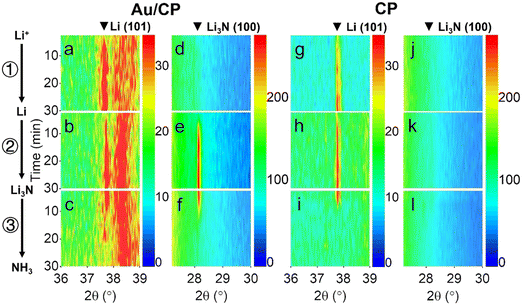 | ||
| Fig. 5 In situ XRD contour maps of (a) and (d) Au/CP and; (g) and (j) CP under Ar atmosphere; (b) and (e) Au/CP and (h) and (k) CP under N2 atmosphere without EtOH; (c) and (f) Au/CP and (i) and (l) CP under N2 atmosphere with EtOH.23 | ||
2.2.2.1 Copper-based materials. Cu does not react with Li and has been demonstrated to be a suitable cathode for Li-mediated eN2RR. Recently, a highly structured Cu electrode on Ni foam substrates was fabricated by Li and coworkers through a hydrogen bubble template (HBT) method (Fig. 6a).58 An NH3 formation rate of 46 ± 6.8 nmol s−1 cmgeo−2 with a corresponding FE and energy efficiency (EE) of 13.3 ± 2.0% and 2.3 ± 0.3% was attained at a current density of −100 mA cmgeo−2 under 20 bar N2 using 2 M LiClO4 in THF as an electrolyte and 1 vol% of EtOH as a proton source. The NH3 FE and EE for HBT Cu were shown to be comparable to Cu foil (NH3 FE: 13.6% ± 1; EE: 3.9 ± 0.3%), while the NH3 formation rate of HBT Cu was over 45 times that of Cu foil (1.0 ± 0.1 nmol s−1 cmgeo−2). It is worth noting that the synthesized HBT Cu electrode shows a great potential for scale up application compared to previously reported electrodes in terms of current density (Fig. 6b). Furthermore, an increase in salt concentration in the electrolyte was observed to lead to improved stability of the system, which may be due to suppressing the formation of a passivating decomposition layer, or it otherwise altering the SEI layer composition.
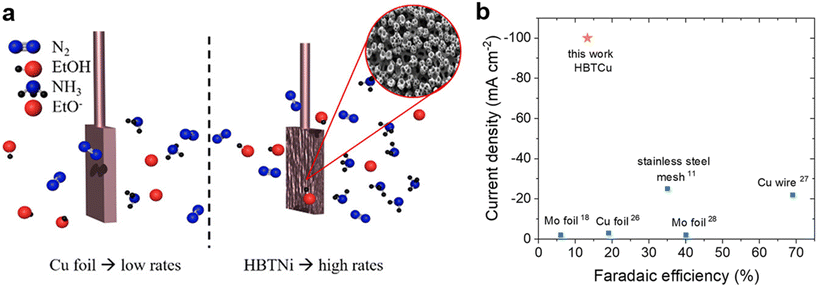 | ||
| Fig. 6 (a) Illustration of Cu foil and HBT Cu for Li-mediated eN2RR; (b) comparison of HBT Cu and previously reported electrode materials in terms of current density and NH3 FE.58 | ||
Zhang et al.14 embedded Cu particles into lithium by sample rolling. They found that the Li in the resulting Cu/Li composite provided a reaction rate over 1000 times faster than bare Li for the lithium nitridation process (Fig. 7a and b). This was attributed to the alteration of nitrogen adsorption and decrease in the total energy required for the nitridation reaction. Reaction of Cu/Li3N with deionized water (2Li3N + 3H2O → 2NH3 + 6LiOH) yielded NH3 (Fig. 7c), which was validated by infrared spectroscopy (Fig. 7d) and Nessler's reagent spectrophotometry. The authors further compared this work with the traditional H–B process in terms of energy consumption for production of 1 kg of NH3 (Fig. 7e). Taking into account that Li, Cu, and HCl are not consumed, only the costs of industrial-grade H2O and N2 and the electricity employed for Li-ion reduction were considered in the calculation. The use of H2O as a hydrogen source instead of H2 provides benefits for eliminating the amount of consumed fossil fuels for yielding H2, thus substantially reducing CO2 emissions. The FE of this eN2RR fixation route using insulated solid electrolyte can reach close to 100%.
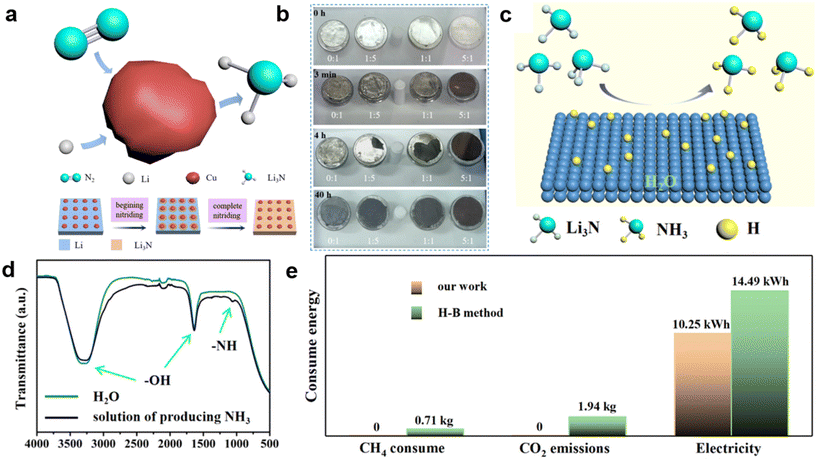 | ||
| Fig. 7 (a) Illustration of Cu-catalyzed lithium nitridation (top panel) and steps for the formation of Li3N/Cu from Li/Cu (bottom panel); (b) catalytic effect of Cu-to-Li mass ratio on the nitridation process; (c) illustration of NH3 synthesis from the reaction of Li3N and H2O; (d) infrared spectra of H2O and the electrolyte solution after reaction; (e) comparison of this work with the H–B process in terms of energy consumption for production of 1 kg of NH3.14 | ||
2.2.2.2 Molybdenum (Mo). In addition to Cu, Mo also does not alloy with Li and has been used as a cathode for Li-mediated eN2RR.6,61 An NH3 FE of ∼10% at a current density of 100 mA cm−2 was achieved on a Mo working electrode in 0.5 M LiClO4 in THF with the addition of a small amount of EtOH (0 to 5 vol%).41 Andersen et al.38 reported a simple strategy for improving the NH3 FE by cycling the applied voltage between a Li deposition favored region and a Li dissolution facilitated regime (Fig. 8a and b). The NH3 FE was enhanced from ∼21.2% under constant Li deposition to 37% after potential cycling on a Mo electrode with 0.3 M LiClO4 electrolyte in THF containing 1 vol% ethanol. Li et al.59 discovered that the addition of a small amount of O2 could greatly improve the NH3 FE and stability of the lithium-mediated eN2RR. A high NH3 FE of up to 78 ± 1.3% was obtained at 0.6 to 0.8 mole% O2 in 20 bar of N2 with 0.3 M LiClO4 electrolyte in THF containing 1 vol% ethanol. The NH3 FE was found to increase with the decrease of Li diffusion rate (Fig. 8c). This can be associated with the fact that Li electrodeposition competes with the N2RR for electrons. Ideally, Li diffusion or deposition should be slow enough to consume a minimal number of electrons while still providing a full monolayer of clean and freshly plated Li to dissociate N2. O2-induced changes in the SEI layer can lead to delayed Li diffusion, thereby boosting the FE toward NH3. The oxygen content also affected the rates of nitrogen and proton diffusion, rN2 and rH, due to induced modification of the SEI layer. An optimal O2 content was proposed to follow as a trade-off between the Li+ diffusivity limited regime and the dominant ORR (over the N2RR) regime (Fig. 8d).
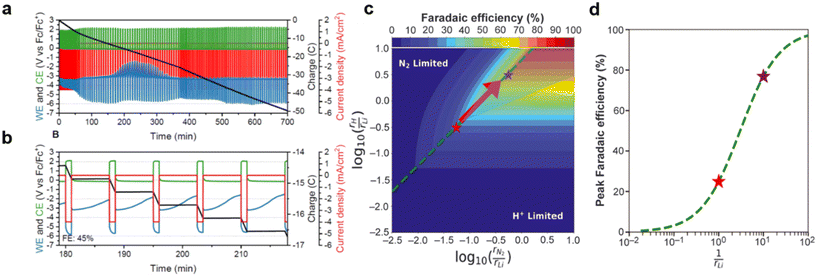 | ||
| Fig. 8 (a) Cycling method between −2.0 and 0.0 mA cm−2 (red) for a total of 100C of charge passed (black); (b) a close-up of the cycling;38 (c) Heatmap of the predicted FE against the ratio of N2 to lithium (x axis) and proton to lithium (y axis) diffusion rates; (d) a one-dimensional plot of NH3 FE cut along the optimal rN2/rH ratio.59 | ||
2.2.2.3 Lithium–liquid alloy-salt (Li–Sn liquid alloy & molten LiCl–KCl). Apart from the application of solid-state electrolytes, the use of liquid alloys with molten salts have recently been reported. To overcome the limitation of the scaling relation between the activation barrier and binding energy of N2, Tang et al.62 introduced a Li-based loop using a Li–Sn liquid alloy (having LiSn, Li7Sn3, Li5Sn2, and Li13Sn5 intermetallic phases) and molten LiCl–KCl salt as a catalyst for the generation of NH3 from N2 and H2 gases at ambient conditions. The looping process involved a three-step reaction cascade. During the first step, the Li present in Li–Sn alloy reacted with N2 to form Li3N, which dissolved readily in the molten salt. In the consecutive second step, the Li3N underwent hydrogenation to yield NH3 and LiH. The third step involved the decomposition of LiH and regeneration of Li metal in the presence of Sn. This looping process at 450 °C exhibited an NH3 yield rate of 0.12 μg s−1 during the 81 h electrocatalytic test (Fig. 9). The highest activity of this catalytic system (Li–Sn alloy and molten LiCl–KCl salt) was found to be 0.249 μmol g−1 h−1, which was higher than that of pure Na but considerably lower than the looping process catalyzed by LiH/Li2NH.62
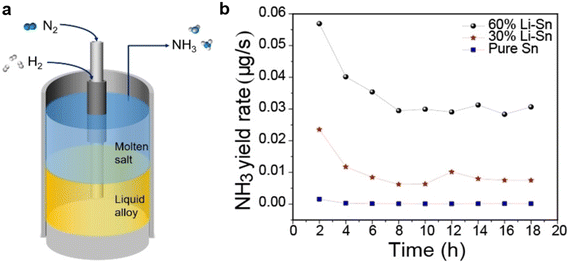 | ||
| Fig. 9 (a) Graphical illustration of Li-eN2RR containing Li–Sn alloy and molten LiCl–KCl salt forming a biphasic system; (b) NH3 yield rate against electrolysis time on Li–Sn and pure Sn.62 | ||
2.2.2.4 Stainless steel cloth (SSC). The use of conventional gas diffusion electrodes (GDEs) with non-aqueous electrolytes is hampered by the absence of hydrophobic repulsion between the solvent and carbon fibre skeleton. A recent study by Lazouski et al.22 demonstrated an approach to overcome transport limitations in THF by using SSC as a cathode and an anode GDE substrate (Fig. 10) for Li-mediated eN2RR, giving rise to an NH3 partial current density and FE of 8.8 ± 1.4 mA cm−2 and 35 ± 6%, respectively. The total NH3 FE did not markedly vary when the flow rate of N2 across the SSC was changed; less NH3 was observed in the gas phase at lower flow rates. However, the NH3 formation rate decreased with electrolysis time. The reason for this degradation needs to be further explored.
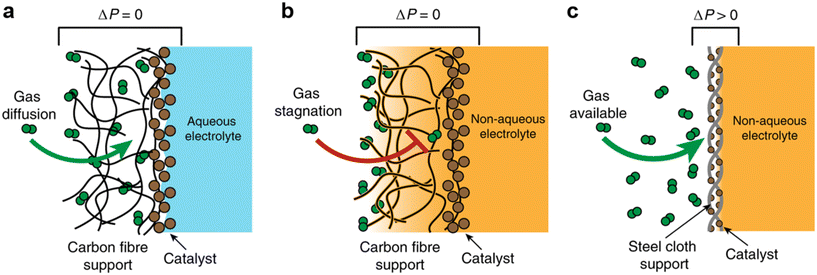 | ||
| Fig. 10 (a) A hydrophobic GDE with an aqueous electrolyte; (b) a hydrophobic GDE with a non-aqueous electrolyte; (c) a catalyst-coated (SSC) GDE with a non-aqueous electrolyte.22 | ||
2.2.3.1 Li+ incorporated poly(N-ethyl-benzene-1,2,4,5-tetracarboxylic diimide)–carbon cloth (Li+–PEBCD/CC). Chen et al.3 reported a dramatic increase in the efficiency and selectivity of the eN2RR process (at ambient conditions) by employing Li+-PEBCD/CC as the catalyst. DFT calculations as well as experimental studies verified the association of the Li+ with the oxygen atoms that inhibit the HER. Further, it also facilitates the adsorption of N2, and the hydrogenation reaction proceeds in a “[O–Li+]·N2–Hx” manner (Fig. 11a). The highest values of FE and NH3 yield rate of 2.85% and 2.01 μg h−1 cm−2 were achieved at −0.5 and −0.7 V, respectively (Fig. 11b and c). The durability tests suggested 82% performance retention and stable behavior of the Li+-PEBCD/CC electrode with a slight change of FE after 6 cycles (Fig. 11d).3
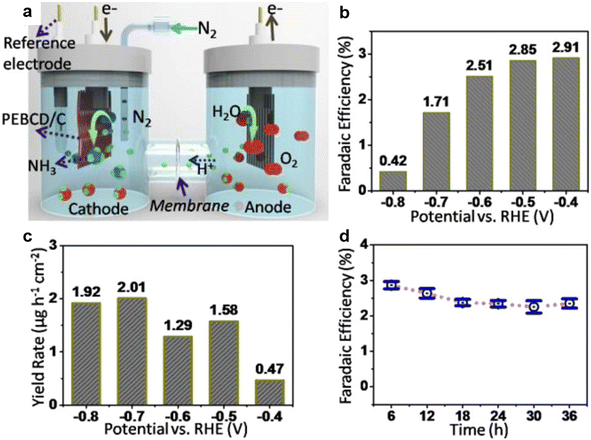 | ||
| Fig. 11 (a) The graphic illustration of the configuration of the electrochemical cell for the eN2RR process; (b) FEs of the Li+-PEBCD/CC catalyst at different potentials during the eN2RR; (c) NH3 yield rate against applied potential during the eN2RR; (d) durability test results for Li+-PEBCD/CC.3 | ||
2.2.3.2 N-doped carbon nanospikes (CNS). Song et al.34 demonstrated the effect of N-doped CNS as a physical catalyst to promote the eN2RR. The catalyst does not contain noble or non-precious metals, but instead the sharp nanospikes of the carbon act as the electrocatalytic surface as they concentrate the electric field at the tips and catalyze the eN2RR process of the dissolved N2 at the electrode. The counter ion (i.e., Li+, Na+, and K+) present in the electrolyte was also observed to critically influence the performance of the reaction by enhancing the electric field and N2 concentration in the Stern layer. Moreover, the CNS suppresses the HER by formation of a cation layer around the tip of the spikes, which excludes water and provides access to a high electric field to the N2 molecules. The counter-ions enhanced the NH3 production rate in the order of Li+ > Na+ > K+. Using LiClO4 as an electrolyte and CNS as a catalyst, an NH3 FE, NH3 yield rate, and energy efficiency of 11.56%, 97.18 μg h−1 cm−2, and 5.25% were achieved, respectively.34
Among the reported catalysts for Li-mediated eN2RR, as illustrated in Table 2, HBT Cu gives the best NH3 yield rate, possibly due to its porous structure with high surface area benefiting the lithium-mediated process. The Cu/Li composite exhibited a 100% NH3 FE. However, the metal-free CNS demonstrated both high yield and FE toward NH3 with a corresponding value of 97.18 μg h−1 cm−2 and 11.56%, respectively.
| Sr # | Cathode catalyst | NH3 FE (%) | NH3 yield/NH3 yield rate | Electrolyte | Ref. |
|---|---|---|---|---|---|
| Noble metal catalyst | |||||
| 1 | Ru NPs@C | 4.2 | 4.46 mg | 1 M LiCF3SO3 in TEGDME | 60 |
| 1.4 | 66 mg | ||||
| 2 | Ag wire | 8.4 | — | 0.2 M LiClO4 in THF with 1 vol% EtOH | 61 |
| 3 | Au/CP | 34 | 50 μg h−1 cm−2 | 0.2 M LiClO4 in THF with 1% EtOH | 23 |
| Non-precious metal catalyst | |||||
| 4 | HBT Cu on Ni foam | 13.3 ± 2 | 46 ± 6.8 nmol s−1 cmgeo−2@−100 mA cmgeo−2 | 2 M LiClO4 in THF with 1 vol% of EtOH | 58 |
| 5 | Cu foil | 18.5 ± 2.9 | 7.9 ± 1.6 nmol s−1 cmgeo−2 | 1 M LiBF4 in THF with 0.1 M EtOH | 11 |
| 6 | Cu/Li composite | 100 | — | — | 14 |
| 7 | Mo | ∼10 | — | 0.5 M LiClO4 in THF with 1 vol% ethanol | 41 |
| 8 | Mo foil spot-welded with Mo wire | 21.2 ± 1.6 | — | 0.3 M LiClO4 in THF with 1 vol% ethanol | 38 |
| 9 | Mo foil spot-welded with Mo wire | 78 ± 1.3 | — | 0.3 M LiClO4 in THF with 1 vol% ethanol (at 0.6 to 0.8 mole% O2 in 20 bar of N2) | 59 |
| 10 | Li–Sn liquid alloy | 0.249 μmol g−1 h−1 | Molten LiCl–KCl | 62 | |
| 11 | SSC | 35 ± 6 | — | 1 M LiBF4 in THF with 0.11 M EtOH | 22 |
| Non-metal catalyst | |||||
| 12 | Li+-PEBCD/CC | 2.85 | 2.01 μg h−1 cm−2 | 0.5 M Li2SO4 (aq) | 3 |
| 13 | CNS | 11.56 | 97.18 μg h−1 cm−2 | 0.25 M LiClO4 (aq) | 34 |
2.3 Electrolytes reported for Li-mediated N2 reduction
In the electrochemical method, a proton donor is required to reduce the N2 (such as LiN3) so that NH3 is released and Li ions are recovered. There are reasons to think that the proton donor's function extends beyond supplying NH3 with H atoms. It may also act as the catalyst for the reaction between Li metal and N2 gas. The thermodynamic activity of the proton donor is significant for selective continuous N2 reduction, according to a theoretical study of general eN2RR.6 In a previous assessment of proton donors, it was found that the identification of the proton donor can significantly alter the NH3 yields in the Li-mediated N2 reduction process.8 The proton donor is the source of hydrogen that is necessary for NH3 formation from N2 in Li-eN2RR.Notably, the electrolyte plays a key role and provides an ideal environment for any electrochemical reactions to take place. However, obtaining a high yield and production rate of NH3 during electrochemical synthesis is seriously hampered by the problem of N2 solubility in traditional aqueous electrolytes. Thus, the most crucial problem must be resolved, namely, the dissolution of a useful concentration of N2 molecules into the electrolyte so that they are accessible to the catalyst surface for their subsequent reduction.63 Ren and co-workers have recently reviewed the N2RR literature, and found that most of the work (90.7%) has been done on catalyst development and only 4.7% on electrolytes.64 Below are some of the recently used electrolytes for Li-mediated eN2RR.
![[triple bond, length as m-dash]](https://www.rsc.org/images/entities/char_e002.gif) N bond over metallic Li and the diffusion processes that results in Li3N at ambient temperature. The reaction was performed with an overnight N2 flow (12 h) and resulted in complete conversion to nitride regardless of the temperature used (within the 22–100 °C), which further resulted in ∼100% conversion efficiency to NH3.1
N bond over metallic Li and the diffusion processes that results in Li3N at ambient temperature. The reaction was performed with an overnight N2 flow (12 h) and resulted in complete conversion to nitride regardless of the temperature used (within the 22–100 °C), which further resulted in ∼100% conversion efficiency to NH3.1
| N2 + 6e− → 2N3− (cathode) | (3) |
| 2N3− + 3H2 → 2NH3 + 6e− (anode) | (4) |
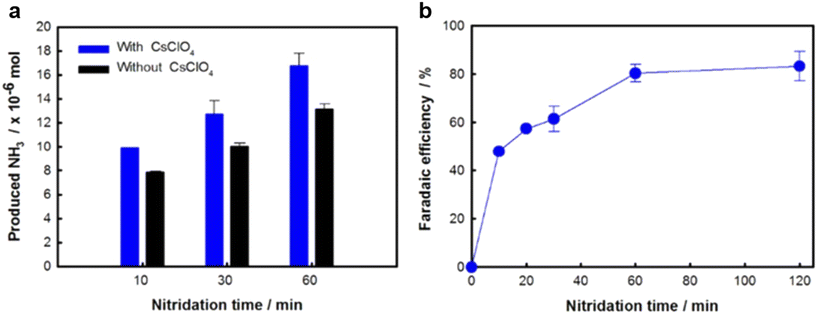 | ||
| Fig. 12 (a) NH3 yield and (b) NH3 FE in the presence and absence of 0.03 M CsClO4 at 220 °C over time.8 | ||
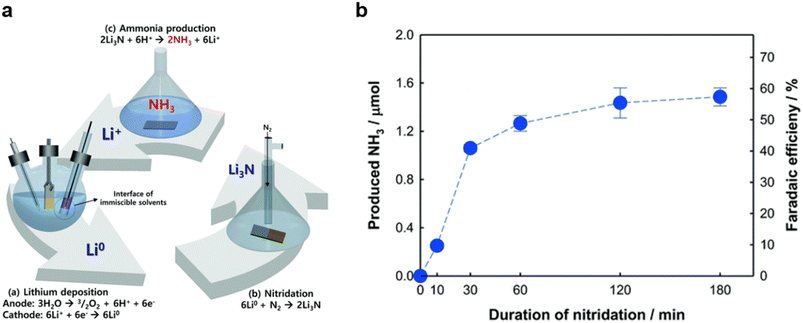 | ||
| Fig. 13 (a) Schematic diagram and (b) NH3 yield and FE of the biphasic hybrid catalytic system catalyzed by LiClO4 (aq) and LiClO4–PMMA composite.66 | ||
 | ||
| Fig. 14 (a) Schematic illustration of eN2RR catalysis using a phosphonium salt; (b) NH3 yield and FE as a function of time.24 | ||
3 Conclusions and future remarks
This review has focused on the considerable advancements during recent years toward the development of a sustainable and green eN2RR process. Li-mediated eN2RR performance such as NH3 yield, FE, current to NH3 efficiency rate, etc., is low when aqueous electrolytes are used at ambient temperature and pressure conditions due to competitive reactions. We have critically discussed the main factors such as the nature of electrolyte, the material of the electrode, and mechanisms involved in the Li-mediated eN2RR. The mechanistic understanding derived through investigation of the various factors that play a vital role in governing the performance parameters will help guide the search for the technological solutions for the current challenges in eN2RR catalysis.The main challenge for the Li-mediated eN2RR process is to design selective electrocatalysts that can boost the activation of N2 and hydrogenation to afford NH3 by actively controlling the mass and charge transport during the process.38 Non-aqueous solvents and different salts as electrolytes have been used to ameliorate the competing HER side reaction,68 with Li-mediated N2 reduction in non-aqueous electrolytes exhibiting a high NH3 yield rate and FE. However, some other serious challenges such as high overpotential, unsustainable proton source from sacrificial solvent, a large ohmic resistance, and organic solvent recovery have arisen.22,64,69–72
To overcome the existing limitations and challenges of Li-eN2RR systems, we propose the following strategies to improve the efficiency of the process: the overpotential for Li+ electrodeposition could be lowered by use of either active Li or its alloys with other metals, which deserves further exploration for N2 activation.70,72 Besides, alternative liquid electrolytes should be investigated for use in Li-mediated eN2RR systems, and the mechanisms of electrolyte decomposition should be explored to avoid the use of conventional low boiling organic electrolytes (e.g., THF).71,73,74 Most of the Li-mediated eN2RR process have been investigated in a batch-type electrochemical cell (i.e., a single compartment or an autoclave), which suffers from the limitation of mass transport due to the low solubility of both N2 and H2 in liquid electrolytes. The limitation of mass transport can be resolved by using continuous-flow electrolyzers to significantly enhance the rate of N2 reduction by providing gaseous reactants at the catalytic surface (Fig. 15a).41,75–77 Solid state electrolyzes can be implemented to realize the selective and efficient synthesis of NH3 at ambient temperature and pressure. To realize electrosynthesis of NH3 at industrial scale, gas diffusion electrodes should be used to continuously providing gaseous reactants to the catalytic active sites. Flow cells and membrane electrode assembly (MEA) electrolyzers should be designed and optimized that could significantly enhance the rate of eN2RR.56,76,77
 | ||
| Fig. 15 (a) Expanded view of the continuous-flow electrolyzer configuration; (b) schematic process of the Li-NRR in a continuous-flow electrolyzer.72 | ||
The eN2RR process requires a proton donor which plays a crucial role in the production of NH3via N2 reduction. A variety of proton donors have been shown to promote the reaction, and the donor's capacity to boost the reaction significantly depends on the proton donor structure and concentration. The proton donors induce changes in the solid electrolyte interphase, thereby facilitating selective diffusion of N2 species to active sites on the electrode for reduction.68 Hence, solid electrolyte interphases can enhance the selectivity as well as NH3 yield by accelerating the homogenous deposition of lithium, as well as hindering the HER and uncontrolled electrolyte decomposition reactions. Lithium fluoride-based electrolytes have been found to achieve high selectivity due to the formation of a fluoride-rich SEI.72 Note that most eN2RR studies applied a sacrificial solvent as a proton donor, which leads to difficulty in scaling up fabrication in batch reactors. To circumvent this issue, employing a hydrogen oxidation reaction (HOR) on the anode (with the hydrogen sourced from water splitting) appears to be a promising strategy to provide a sustainable hydrogen source for NH3 production (Fig. 15b). To this end, the design and development of active and robust HOR anode materials (such as PtAu) in organic electrolytes for replacing the archetype Pt is crucial.
More efforts are suggested to be devoted to conducting deep mechanistic investigations.78 Along with experimental studies, theoretical calculations in combination with in situ/operando analysis using advanced techniques could help reveal the phase changes, reaction pathways, and insights into the composition of the SEI layer and its interaction with adsorbed surface species.79,80 This will aid in the rational design of efficient Li-eN2RR systems for practical applications at ambient conditions.81–85
Among others, standard protocols should be developed for accurate quantification of the N2RR process. This is crucial to tackle the problem of false positives due to the presence of N2 species from several other sources such as the solvent, electrolyte, or the catalyst itself. It should be ensured through a rigorous procedure (i.e., gas purification and quantitative isotope measurements) that the only N2 species that are utilized to yield NH3via the eN2RR should be the N2 reactant itself so that the catalyst efficiency can be estimated with accuracy.86 Due to the emerging eN2RR, we believe that the sustainable and green synthesis of NH3 will be extended for practical implementation in industry in the near future, which will bring a revolution in NH3-based energy storage and conversion materials/devices.87
Conflicts of interest
The authors declare that they have no conflict of interest.Acknowledgements
This work was supported by the National Natural Science Foundation of China (no. 21972010), National Key Research and Development Program of China (No. 2022YFC2105900), and Beijing Natural Science Foundation (no. 2192039).References
- J. M. McEnaney, A. R. Singh, J. A. Schwalbe, J. Kibsgaard, J. C. Lin, M. Cargnello, T. F. Jaramillo and J. K. Nørskov, Ammonia synthesis from N2 and H2O using a lithium cycling electrification strategy at atmospheric pressure, Energy Environ. Sci., 2017, 10, 1621–1630 RSC.
- Ammonia Market (By Product Form: Liquid, Gas, Powder; By Application: Fertilizers, Refrigerants, Pharmaceuticals, Textile, Others) – Global Industry Analysis, Size, Share, Growth, Trends, Regional Outlook, and Forecast 2022–2030.
- G.-F. Chen, X. Cao, S. Wu, X. Zeng, L.-X. Ding, M. Zhu and H. Wang, Ammonia electrosynthesis with high selectivity under ambient conditions via a Li+ incorporation strategy, J. Am. Chem. Soc., 2017, 139, 9771–9774 CrossRef CAS PubMed.
- S. Chen, S. Perathoner, C. Ampelli, C. Mebrahtu, D. Su and G. Centi, Room-temperature electrocatalytic synthesis of NH3 from H2O and N2 in a gas–liquid–solid three-phase reactor, ACS Sustainable Chem. Eng., 2017, 5, 7393–7400 CrossRef CAS.
- F. Fichter, P. Girard and H. Erlenmeyer, Elektrolytische bindung von komprimiertem stickstoff bei gewöhnlicher temperatur, Helv. Chim. Acta, 1930, 13, 1228–1236 CrossRef CAS.
- A. Tsuneto, A. Kudo and T. Sakata, Lithium-mediated electrochemical reduction of high pressure N2 to NH3, J. Electroanal. Chem., 1994, 367, 183–188 CrossRef CAS.
- H. K. Lee, C. S. L. Koh, Y. H. Lee, C. Liu, I. Y. Phang, X. Han, C.-K. Tsung and X. Y. Ling, Favoring the unfavored: Selective electrochemical nitrogen fixation using a reticular chemistry approach, Sci. Adv., 2018, 4, eaar3208 CrossRef PubMed.
- K. Kim, H. Cho, S. H. Jeon, S. J. Lee, C.-Y. Yoo, J.-N. Kim, J. W. Choi, H. C. Yoon and J.-I. Han, Lithium-Mediated ammonia electro-synthesis: effect of CsClO4 on lithium plating efficiency and ammonia synthesis, J. Electrochem. Soc., 2018, 165, F1027–F1031 CrossRef CAS.
- Q. Wang, J. Guo and P. Chen, Recent progress towards mild-condition ammonia synthesis, J. Energy Chem., 2019, 36, 25–36 CrossRef.
- V. S. Marakatti and E. M. Gaigneaux, Recent advances in heterogeneous catalysis for ammonia synthesis, ChemCatChem, 2020, 12, 5838–5857 CrossRef CAS.
- N. Lazouski, Z. J. Schiffer, K. Williams and K. Manthiram, Understanding continuous lithium-mediated electrochemical nitrogen reduction, Joule, 2019, 3, 1127–1139 CrossRef CAS.
- R. Sažinas, K. Li, S. Z. Andersen, M. Saccoccio, S. Li, J. B. Pedersen, J. Kibsgaard, P. C. K. Vesborg, D. Chakraborty and I. Chorkendorff, Oxygen-enhanced chemical stability of lithium-mediated electrochemical ammonia synthesis, J. Phys. Chem. Lett., 2022, 13, 4605–4611 CrossRef PubMed.
- K. Krempl, J. B. Pedersen, J. Kibsgaard, P. C. K. Vesborg and I. Chorkendorff, Electrolyte acidification from anode reactions during lithium mediated ammonia synthesis, Electrochem. Commun., 2022, 134, 107186 CrossRef CAS.
- Z. Zhang, Y. Zhao, B. Sun, J. Xu, Q. Jin, H. Lu, N. Lyu, Z.-M. Dang and Y. Jin, Copper particle-enhanced lithium-mediated synthesis of green ammonia from water and nitrogen, ACS Appl. Mater. Interfaces, 2022, 14, 19419–19425 CrossRef CAS PubMed.
- R. Subbaraman, D. Tripkovic, D. Strmcnik, K.-C. Chang, M. Uchimura, A. P. Paulikas, V. Stamenkovic and N. M. Markovic, Enhancing hydrogen evolution activity in water splitting by tailoring Li +-Ni(OH)2-Pt interfaces, Science, 2011, 334, 1256–1260 CrossRef CAS PubMed.
- A. Guha, S. Narayanaru and T. N. Narayanan, Tuning the hydrogen evolution reaction on metals by lithium salt, ACS Appl. Energy Mater., 2018, 1, 7116–7122 CrossRef CAS.
- M.-M. Shi, D. Bao, S.-J. Li, B.-R. Wulan, J.-M. Yan and Q. Jiang, Anchoring PdCu amorphous nanocluster on graphene for electrochemical reduction of N2 to NH3 under ambient conditions in aqueous solution, Adv. Energy Mater., 2018, 8, 1800124 CrossRef.
- L. Zhang, X. Ji, X. Ren, Y. Ma, X. Shi, Z. Tian, A. M. Asiri, L. Chen, B. Tang and X. Sun, Electrochemical ammonia synthesis via nitrogen reduction reaction on a MoS2 catalyst: theoretical and experimental studies, Adv. Mater., 2018, 30, 1800191 CrossRef PubMed.
- E. Skúlason, T. Bligaard, S. Gudmundsdóttir, F. Studt, J. Rossmeisl, F. Abild-Pedersen, T. Vegge, H. Jónsson and J. K. Nørskov, A theoretical evaluation of possible transition metal electro-catalysts for N2 reduction, Phys. Chem. Chem. Phys., 2012, 14, 1235–1245 RSC.
- B. H. R. Suryanto, C. S. M. Kang, D. Wang, C. Xiao, F. Zhou, L. M. Azofra, L. Cavallo, X. Zhang and D. R. MacFarlane, Rational electrode–electrolyte design for efficient ammonia electrosynthesis under ambient conditions, ACS Energy Lett., 2018, 3, 1219–1224 CrossRef CAS.
- J. Yang, W. Weng and W. Xiao, Electrochemical synthesis of ammonia in molten salts, J. Energy Chem., 2020, 43, 195–207 CrossRef.
- N. Lazouski, M. Chung, K. Williams, M. L. Gala and K. Manthiram, Non-aqueous gas diffusion electrodes for rapid ammonia synthesis from nitrogen and water-splitting-derived hydrogen, Nat. Catal., 2020, 3, 463–469 CrossRef CAS.
- L. Gao, Y. Cao, C. Wang, X. Yu, W. Li, Y. Zhou, B. Wang, Y. Yao, C. Wu, W. Luo and Z. Zou, Domino effect: Gold electrocatalyzing lithium reduction to accelerate nitrogen fixation, Angew. Chem., 2021, 133, 5317–5321 CrossRef.
- B. H. R. Suryanto, K. Matuszek, J. Choi, R. Y. Hodgetts, H.-L. Du, J. M. Bakker, C. S. M. Kang, P. V. Cherepanov, A. N. Simonov and D. R. MacFarlane, Nitrogen reduction to ammonia at high efficiency and rates based on a phosphonium proton shuttle, Science, 2021, 372, 1187–1191 CrossRef CAS PubMed.
- A. Jain, H. Miyaoka, S. Kumar, T. Ichikawa and Y. Kojima, A new synthesis route of ammonia production through hydrolysis of metal–nitrides, Int. J. Hydrogen Energy, 2017, 42, 24897–24903 CrossRef CAS.
- T. Yamaguchi, K. Shinzato, K. Yamamoto, Y. Wang, Y. Nakagawa, S. Isobe, T. Ichikawa, H. Miyaoka and T. Ichikawa, Pseudo catalytic ammonia synthesis by lithium–tin alloy, Int. J. Hydrogen Energy, 2020, 45, 6806–6812 CrossRef CAS.
- F. Chang, Y. Guan, X. Chang, J. Guo, P. Wang, W. Gao, G. Wu, J. Zheng, X. Li and P. Chen, Alkali and alkaline earth hydrides-driven N2 activation and transformation over Mn nitride catalyst, J. Am. Chem. Soc., 2018, 140, 14799–14806 CrossRef CAS PubMed.
- Y. Gong, H. Li, J. Wu, X. Song, X. Yang, X. Bao, X. Han, M. Kitano, J. Wang and H. Hosono, Unique catalytic mechanism for Ru-loaded ternary intermetallic electrides for ammonia synthesis, J. Am. Chem. Soc., 2022, 144, 8683–8692 CrossRef CAS PubMed.
- P. Wang, F. Chang, W. Gao, J. Guo, G. Wu, T. He and P. Chen, Breaking scaling relations to achieve low-temperature ammonia synthesis through LiH-mediated nitrogen transfer and hydrogenation, Nat. Chem., 2017, 9, 64–70 CrossRef CAS PubMed.
- W. Gao, J. Guo, P. Wang, Q. Wang, F. Chang, Q. Pei, W. Zhang, L. Liu and P. Chen, Production of ammonia via a chemical looping process based on metal imides as nitrogen carriers, Nat. Energy, 2018, 3, 1067–1075 CrossRef CAS.
- A. Sclafani, V. Augugliaro and M. Schiavello, Dinitrogen electrochemical reduction to ammonia over Iron cathode in aqueous medium, J. Electrochem. Soc., 1983, 130, 734–736 CrossRef CAS.
- S. Chen, S. Perathoner, C. Ampelli, C. Mebrahtu, D. Su and G. Centi, Electrocatalytic synthesis of ammonia at room temperature and atmospheric pressure from water and nitrogen on a carbon-nanotube-based electrocatalyst, Angew. Chem., Int. Ed., 2017, 56, 2699–2703 CrossRef CAS PubMed.
- M. Nazemi, S. R. Panikkanvalappil and M. A. El-Sayed, Enhancing the rate of electrochemical nitrogen reduction reaction for ammonia synthesis under ambient conditions using hollow gold nanocages, Nano Energy, 2018, 49, 316–323 CrossRef CAS.
- Y. Song, D. Johnson, R. Peng, D. K. Hensley, P. V. Bonnesen, L. Liang, J. Huang, F. Yang, F. Zhang, R. Qiao, A. P. Baddorf, T. J. Tschaplinski, N. L. Engle, M. C. Hatzell, Z. Wu, D. A. Cullen, H. M. Meyer, B. G. Sumpter and A. J. Rondinone, A physical catalyst for the electrolysis of nitrogen to ammonia, Sci. Adv., 2018, 4, e1700336 CrossRef PubMed.
- H. Mikosch, E. L. Uzunova and G. St. Nikolov, Interaction of molecular nitrogen and oxygen with extraframework cations in zeolites with double six-membered rings of oxygen-bridged silicon and aluminum atoms: A DFT study, J. Phys. Chem. B, 2005, 109, 11119–11125 CrossRef CAS PubMed.
- S. Giddey, S. P. S. Badwal and A. Kulkarni, Review of electrochemical ammonia production technologies and materials, Int. J. Hydrogen Energy, 2013, 38, 14576–14594 CrossRef CAS.
- Z. Yu, Y. Cui and Z. Bao, Design principles of artificial solid electrolyte interphases for lithium-metal anodes, Cell Rep. Phys. Sci., 2020, 1, 100119 CrossRef.
- S. Z. Andersen, M. J. Statt, V. J. Bukas, S. G. Shapel, J. B. Pedersen, K. Krempl, M. Saccoccio, D. Chakraborty, J. Kibsgaard, P. C. K. Vesborg, J. Nørskov and I. Chorkendorff, Increasing stability, efficiency, and fundamental understanding of lithium-mediated electrochemical nitrogen reduction, Energy Environ. Sci., 2020, 13, 4291–4300 RSC.
- J. H. Montoya, C. Tsai, A. Vojvodic and J. K. Nørskov, The challenge of electrochemical ammonia synthesis: a new perspective on the role of nitrogen scaling relations, ChemSusChem, 2015, 8, 2180–2186 CrossRef CAS PubMed.
- X. Cai, C. Fu, H. Iriawan, F. Yang, A. Wu, L. Luo, S. Shen, G. Wei, Y. Shao-Horn and J. Zhang, Lithium-mediated electrochemical nitrogen reduction: Mechanistic insights to enhance performance, iScience, 2021, 24, 103105 CrossRef CAS PubMed.
- J. A. Schwalbe, M. J. Statt, C. Chosy, A. R. Singh, B. A. Rohr, A. C. Nielander, S. Z. Andersen, J. M. McEnaney, J. G. Baker, T. F. Jaramillo, J. K. Norskov and M. Cargnello, A combined theory-experiment analysis of the surface species in lithiu-mediated NH3 Electrosynthesis, ChemElectroChem, 2020, 7, 1542–1549 CrossRef CAS.
- J. K. Nørskov, J. Rossmeisl, A. Logadottir, L. Lindqvist, J. R. Kitchin, T. Bligaard and H. Jónsson, Origin of the overpotential for oxygen reduction at a fuel-cell cathode, J. Phys. Chem. B, 2004, 108, 17886–17892 CrossRef.
- O. Westhead, M. Spry, Z. Shen, A. Bagger, H. Yadegari, S. Favero, R. Tort, M. Titirici, M. Ryan, R. Jervis, A. Aguadero, J. Douglas, A. Regoutz, A. Grimaud and I. E. L. Stephens, Solvation and stability in lithium-mediated nitrogen reduction, Meet. Abstr., 2022, MA2022-02, 1929 CrossRef.
- O. Westhead, M. Spry, A. Bagger, Z. Shen, H. Yadegari, S. Favero, R. Tort, M. Titirici, M. P. Ryan, R. Jervis, Y. Katayama, A. Aguadero, A. Regoutz, A. Grimaud and I. E. L. Stephens, The role of ion solvation in lithium mediated nitrogen reduction, J. Mater. Chem. A, 2023 10.1039/D2TA07686A.
- D. Ma, Z. Zeng, L. Liu, X. Huang and Y. Jia, Computational evaluation of electrocatalytic nitrogen reduction on TM single-, double-, and triple-atom catalysts (TM = Mn, Fe, Co, Ni) based on graphdiyne monolayers, J. Phys. Chem. C, 2019, 123, 19066–19076 CrossRef CAS.
- H. Dong, W. Xu, J. Xie, Y. Ding, Q. Wang and L. Zhou, Computational screening on two-dimensional metal-embedded poly-phthalocyanine as cathode catalysts in lithium-nitrogen batteries, Appl. Surf. Sci., 2022, 604, 154507 CrossRef CAS.
- D. Maniscalco, D. A. Rudolph, E. Nadimi and I. Frank, The first reaction steps of lithium-mediated ammonia synthesis: Ab Initio Simulation, Nitrogen, 2022, 3, 404–413 CrossRef CAS.
- H. Tachikawa, Mechanism of dissolution of a lithium salt in an electrolytic solvent in a lithium ion secondary battery: A direct Ab Initio molecular dynamics (AIMD) study, ChemPhysChem, 2014, 15, 1604–1610 CrossRef CAS PubMed.
- E. Carrasco, M. A. Brown, M. Sterrer, H.-J. Freund, K. Kwapien, M. Sierka and J. Sauer, Thickness-dependent hydroxylation of MgO(001) thin films, J. Phys. Chem. C, 2010, 114, 18207–18214 CrossRef CAS.
- V. Kyriakou, I. Garagounis, E. Vasileiou, A. Vourros and M. Stoukides, Progress in the electrochemical synthesis of ammonia, Catal. Today, 2017, 286, 2–13 CrossRef CAS.
- Y. Abghoui and E. Skúlason, Onset potentials for different reaction mechanisms of nitrogen activation to ammonia on transition metal nitride electro-catalysts, Catal. Today, 2017, 286, 69–77 CrossRef CAS.
- X. Yang, S. Kattel, J. Nash, X. Chang, J. H. Lee, Y. Yan, J. G. Chen and B. Xu, Quantification of active sites and elucidation of the reaction mechanism of the electrochemical nitrogen reduction reaction on vanadium nitride, Angew. Chem., Int. Ed., 2019, 58, 13768–13772 CrossRef CAS PubMed.
- X. Cui, C. Tang and Q. Zhang, A review of electrocatalytic reduction of dinitrogen to ammonia under ambient conditions, Adv. Energy Mater., 2018, 8, 1800369 CrossRef.
- A. Seggio, F. Chevallier, M. Vaultier and F. Mongin, Lithium-mediated zincation of pyrazine, pyridazine, pyrimidine, and quinoxaline, J. Org. Chem., 2007, 72, 6602–6605 CrossRef CAS PubMed.
- Y. Sun, Y. Wang, H. Li, W. Zhang, X.-M. Song, D.-M. Feng, X. Sun, B. Jia, H. Mao and T. Ma, Main group metal elements for ambient-condition electrochemical nitrogen reduction, J. Energy Chem., 2021, 62, 51–70 CrossRef CAS.
- D. Yao, C. Tang, P. Wang, H. Cheng, H. Jin, L.-X. Ding and S.-Z. Qiao, Electrocatalytic green ammonia production beyond ambient aqueous nitrogen reduction, Chem. Eng. Sci., 2022, 257, 117735 CrossRef CAS.
- X. Fu, J. Zhang and Y. Kang, Electrochemical reduction of CO2 towards multi-carbon products via a two-step process, React. Chem. Eng., 2021, 6, 612–628 RSC.
- K. Li, S. G. Shapel, D. Hochfilzer, J. B. Pedersen, K. Krempl, S. Z. Andersen, R. Sažinas, M. Saccoccio, S. Li, D. Chakraborty, J. Kibsgaard, P. C. K. Vesborg, J. K. Nørskov and I. Chorkendorff, Increasing current density of li-mediated ammonia synthesis with high surface area copper electrodes, ACS Energy Lett., 2022, 7, 36–41 CrossRef CAS.
- K. Li, S. Z. Andersen, M. J. Statt, M. Saccoccio, V. J. Bukas, K. Krempl, R. Sa, D. Chakraborty, J. Kibsgaard, P. C. K. Vesborg, J. K. Nørskov and I. Chorkendorff, Enhancement of lithium-mediated ammonia synthesis by addition of oxygen, Science, 2021, 374, 1593–1597 CrossRef CAS PubMed.
- X. Ma, J. Li, H. Zhou and H. Sun, Continuous ammonia synthesis using Ru nanoparticles based on Li–N2 battery, Mater. Today Energy, 2022, 29, 101113 CrossRef CAS.
- A. Tsuneto, A. Kudo and T. Sakata, Efficient electrochemical reduction of N2 to NH3 catalyzed by lithium, Chem. Lett., 1993, 22, 851–854 CrossRef.
- Z. Tang, X. Meng, Y. Shi and X. Guan, Lithium-based loop for ambient-pressure ammonia synthesis in a liquid alloy-salt catalytic system, ChemSusChem, 2021, 14, 4697–4707 CrossRef CAS PubMed.
- A. Biswas, S. Kapse, B. Ghosh, R. Thapa and R. S. Dey, Lewis acid–dominated aqueous electrolyte acting as co-catalyst and overcoming N2 activation issues on catalyst surface, Proc. Natl. Acad. Sci. U. S. A., 2022, 119, e2204638119 CrossRef CAS PubMed.
- Y. Ren, C. Yu, X. Tan, H. Huang, Q. Wei and J. Qiu, Strategies to suppress hydrogen evolution for highly selective electrocatalytic nitrogen reduction: Challenges and perspectives, Energy Environ. Sci., 2021, 14, 1176–1193 RSC.
- T. Goto and Y. Ito, Electrochemical reduction of nitrogen gas in a molten chloride system, Electrochim. Acta, 1998, 43, 3379–3384 CrossRef CAS.
- K. Kim, Y. Chen, J.-I. Han, H. C. Yoon and W. Li, Lithium-mediated ammonia synthesis from water and nitrogen: A membrane-free approach enabled by an immiscible aqueous/organic hybrid electrolyte system, Green Chem., 2019, 21, 3839–3845 RSC.
- H.-L. Du, M. Chatti, R. Y. Hodgetts, P. V. Cherepanov, C. K. Nguyen, K. Matuszek, D. R. MacFarlane and A. N. Simonov, Electroreduction of nitrogen with almost 100% current-to-ammonia efficiency, Nature, 2022, 609, 722–727 CrossRef CAS PubMed.
- N. Lazouski, K. J. Steinberg, M. L. Gala, D. Krishnamurthy, V. Viswanathan and K. Manthiram, Proton donors induce a differential transport effect for selectivity toward ammonia in lithium-mediated nitrogen reduction, ACS Catal., 2022, 12, 5197–5208 CrossRef CAS.
- R. Sažinas, S. Z. Andersen, K. Li, M. Saccoccio, K. Krempl, J. B. Pedersen, J. Kibsgaard, P. C. K. Vesborg, D. Chakraborty and I. Chorkendorff, Towards understanding of electrolyte degradation in lithium-mediated non-aqueous electrochemical ammonia synthesis with gas chromatography-mass spectrometry, RSC Adv., 2021, 11, 31487–31498 RSC.
- L. Li, C. Tang, H. Jin, K. Davey and S.-Z. Qiao, Main-group elements boost electrochemical nitrogen fixation, Chem, 2021, 7, 3232–3255 CAS.
- J. M. McEnaney, S. J. Blair, A. C. Nielander, J. A. Schwalbe, D. M. Koshy, M. Cargnello and T. F. Jaramillo, Electrolyte engineering for efficient electrochemical nitrate reduction to ammonia on a titanium electrode, ACS Sustainable Chem. Eng., 2020, 8, 2672–2681 CrossRef CAS.
- X. Fu, J. B. Pedersen, Y. Zhou, M. Saccoccio, S. Li, R. Sažinas, K. Li, S. Z. Andersen, A. Xu, N. H. Deissler, J. B. V. Mygind, C. Wei, J. Kibsgaard, P. C. K. Vesborg, J. K. Nørskov and I. Chorkendorff, Continuous-flow electrosynthesis of ammonia by nitrogen reduction and hydrogen oxidation, Science, 2023, 379, 707–712 CrossRef CAS PubMed.
- D. Krishnamurthy, N. Lazouski, M. L. Gala, K. Manthiram and V. Viswanathan, Closed-loop electrolyte design for lithium-mediated ammonia synthesis, ACS Cent. Sci., 2021, 7, 2073–2082 CrossRef CAS PubMed.
- P. V. Cherepanov, M. Krebsz, R. Y. Hodgetts, A. N. Simonov and D. R. MacFarlane, Understanding the factors determining the faradaic efficiency and rate of the lithium redox-mediated N2 reduction to ammonia, J. Phys. Chem. C, 2021, 125, 11402–11410 CrossRef CAS.
- S. J. Blair, M. Doucet, J. F. Browning, K. Stone, H. Wang, C. Halbert, J. Avilés Acosta, J. A. Zamora Zeledón, A. C. Nielander, A. Gallo and T. F. Jaramillo, Lithium-mediated electrochemical nitrogen reduction: tracking electrode–electrolyte interfaces via time-resolved neutron reflectometry, ACS Energy Lett., 2022, 7, 1939–1946 CrossRef CAS.
- X. Zhao, G. Hu, G. Chen, H. Zhang, S. Zhang and H. Wang, Comprehensive understanding of the thriving ambient electrochemical nitrogen reduction reaction, Adv. Mater., 2021, 33, 2007650 CrossRef CAS PubMed.
- H. Tao, C. Lian, H. Jiang, C. Li, H. Liu and R. Roij, Enhancing electrocatalytic N2 reduction via tailoring the electric double layers, AIChE J., 2021, 68, 17549 Search PubMed.
- Q. Qin and M. Oschatz, Overcoming chemical inertness under ambient conditions: A critical view on recent developments in ammonia synthesis via electrochemical N2 reduction by asking five questions, ChemElectroChem, 2020, 7, 878–889 CrossRef CAS.
- B. Lassalle-Kaiser, S. Gul, J. Kern, V. K. Yachandra and J. Yano, In situ/operando studies of electrocatalysts using hard X-ray spectroscopy, J. Electron Spectrosc. Relat. Phenom., 2017, 221, 18–27 CrossRef CAS PubMed.
- Y. Yao, S. Zhu, H. Wang, H. Li and M. Shao, A spectroscopic study on the nitrogen electrochemical reduction reaction on gold and platinum surfaces, J. Am. Chem. Soc., 2018, 140, 1496–1501 CrossRef CAS PubMed.
- M. Nazemi and M. A. El-Sayed, Managing the nitrogen cycle via plasmonic (photo)electrocatalysis: toward circular economy, Acc. Chem. Res., 2021, 54, 4294–4304 CrossRef CAS PubMed.
- C. MacLaughlin, Role for standardization in electrocatalytic ammonia synthesis: A conversation with Leo Liu, Lauren Greenlee, and Douglas MacFarlane, ACS Energy Lett., 2019, 4, 1432–1436 CrossRef CAS.
- C. Lee and Q. Yan, Electrochemical reduction of nitrogen to ammonia: Progress, challenges and future outlook, Curr. Opin. Electrochem., 2021, 29, 100808 CrossRef CAS.
- C. Li, T. Wang and J. Gong, Alternative strategies toward sustainable ammonia synthesis, Trans. Tianjin Univ., 2020, 26, 67–91 CrossRef CAS.
- C. Guo, J. Ran, A. Vasileff and S.-Z. Qiao, Rational design of electrocatalysts and photo(electro)catalysts for nitrogen reduction to ammonia (NH3) under ambient conditions, Energy Environ. Sci., 2018, 11, 45–56 RSC.
- J. Choi, B. H. R. Suryanto, D. Wang, H.-L. Du, R. Y. Hodgetts, F. M. Ferrero Vallana, D. R. MacFarlane and A. N. Simonov, Identification and elimination of false positives in electrochemical nitrogen reduction studies, Nat. Commun., 2020, 11, 5546 CrossRef CAS PubMed.
- F. Chang, W. Gao, J. Guo and P. Chen, Emerging materials and methods toward ammonia-based energy storage and conversion, Adv. Mater., 2021, 33, 2005721 CrossRef CAS PubMed.
Footnote |
| † These authors contributed equally to this work. |
| This journal is © Institute of Process Engineering of CAS 2023 |




